In the context of the golf swing, power is equal to speed. The more speed that you can develop in the downswing, the more power you can put into your shots. When someone says they are a powerful golfer, what they really mean is that they can create a lot of club head speed through impact. There is no sense in trying to 'overpower' or 'muscle' your golf shots down the fairway – the only way to hit long shots is through speed. If you look at the bodies of the players on the PGA Tour, this makes sense. While the typical player is highly fit, they are not muscle-bound people. Instead, they tend to be slender, flexible, and able to turn quickly through the ball.
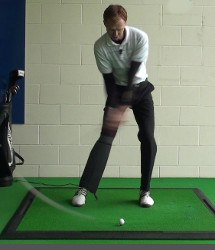
Unfortunately, many of the golfers who have this power available to them don't end up using is properly. It is easy to waste power in golf if you don't understand where it is coming from in the first place.
It seems that everyone wants more power in their golf game. And while plenty of other aspects of the game are as important – or more important – there is no doubt that power can be beneficial in the pursuit of lower scores. In this article, we’d like to talk all about power in golf, including discussions on how it can help, what you can do to build more power, and more.
As you read this article, it’s important to remember that the definition of a powerful swing is different for everyone. A professional golfer might only feel powerful if he can launch drives down the fairway in excess of 300-yards. On the other hand, the average weekend player might be satisfied to reach the 250-yard mark off the tee. Whatever your goals happen to be, the best course of action is to work steadily and consistently toward those goals until you are able to make them a reality on the course.
All of the content below is based on a right-handed golfer. If you happen to play left-handed, please take a moment to reverse the directions as necessary.
— Why Power Matters
If you are looking for some motivation to work on the power that you create in your golf game, this section should serve that purpose nicely. The list below highlights a few of the many ways you may be able to benefit if you increase your overall power. Of course, your results may vary, so it’s possible that not all of these points will show up in your game. However, even if only a couple of them are seen, that should be more than enough payoff to make it worth your effort.
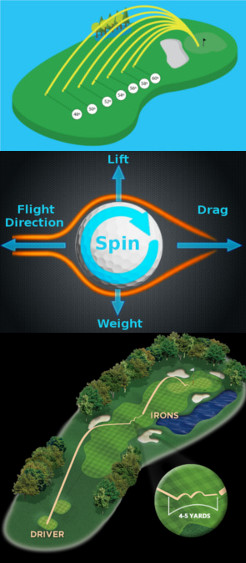
- Shorten the course. When you think of power in golf, you probably think first about hitting long drives from the tee. And, to be sure, that’s a big part of the equation. Launching long drives on par four and five holes helps to effectively shorten the course. You will have shorter approach shots, allowing you to use shorter clubs and be more aggressive as you head into the greens. Even adding 10 yards to your average drive will often let you hit one less club for an approach shot – an eight iron rather than a seven iron, for example. That might not sound like a big difference, but it should serve you save you strokes in the long run. Also, adding length off the tee might bring into play the possibility of reaching some par five greens in two, which is a great way to pick up an ‘easy’ birdie from time to time. From the players on the PGA Tour on down to the average weekend golfer at his or her local club, there is no doubt that driving the ball further can help to produce lower scores.
- Add valuable spin. Not only can power help you to hit longer shots, but it can also help you increase your spin rate – and when used correctly, that higher spin rate can help you leave the ball closer to the hole. Specifically, spinning your wedges aggressively will allow them to stop quickly on firm greens, hopefully setting up more than your fair share of makeable birdie putts. With regard to spin, you do need to pay attention to managing your spin rate on the longer clubs like the driver. A high spin rate can be useful when hitting a wedge approach, but it is usually a hindrance when you have a driver in your hands. If you find that your driver spin rate gets out of control as your power increases, consider working with a local club fitter to dial in your equipment just right. With the right gear, you should be able to keep your driver spin down while letting your wedges spin as much as they want.
- Get out of trouble. In some cases, there is nothing like raw power to get your ball out of trouble and back into position. For instance, if you find your ball resting in some deep grass after a poor drive, a powerful swing will help you carve the ball out of that position and back to a better spot on the course. Without the necessary power to cut through the grass, you might be forced to chip out and play your next shot from a long distance. Power alone isn’t always enough to get yourself out of trouble after you make a mistake, but it certainly is a nice ally to have on your side.
- Use controlled shots. Sometimes, the advantage of being a powerful player is not seen in the form of a massive drive or high iron shot. Rather, on some occasions, power can be an advantage because you can club down for control and still get the distance you need to position the ball properly. For example, imagine you are playing a narrow 400-yard par four. There is water to the right of the fairway and deep bunkers to the left, so you really need to find a way to keep the ball on the short grass. For a player without a lot of power, it might be necessary to hit the driver – even though that may bring in more risk of missing the target and getting in trouble. If you have plenty of power at your disposal, you can leave the driver in your bag and instead hit a three wood or even a hybrid to get in play. You will have increased your chances of hitting the fairway as compared to hitting a driver, yet you will still get enough distance to set up a reasonable approach shot. This method of clubbing down for control is an important but overlooked advantage that comes with possessing some serious swing speed.
Power opens up a lot of opportunities on the golf course. It will not solve all of your ills, of course, as you still need to perform well in areas like putting, chipping, course management, and more. With that said, a powerful player will always have some degree of advantage over a shorter hitter, just because so many things can be accomplished with added distance and spin rate.
— How to Improve Your Power in Golf
If it were easy to improve your power in golf, everyone would do it. So, you shouldn’t expect to make a couple of changes and suddenly be hitting the ball massively farther than ever before. You can work your way incrementally up toward longer drives and more powerful swings, however, if you consistently point your efforts in the right direction. Let’s look at a few ways that you can attempt to track down added power on the links.
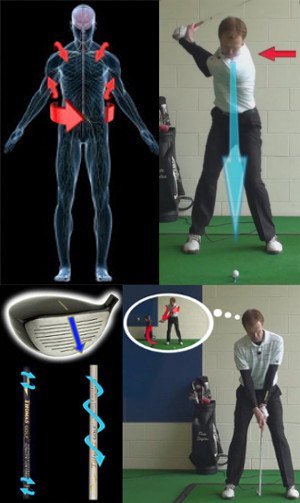
| GOLF FIXES BY PGA PROS |
|---|
| Timing The Golf Swing Transition Correctly To Deliver Power | Video | Article |
| In Golf Right Arm Close To Body Means Power In Your Swing | Video | Article |
| Widen Stance to Add Power & Accuracy in Golf | Video | Article |
| Unleash Golf Swing Power By Firing The Club Down To Target | Video | Article |
| The Correct Way To Hit A Power Fade For Distance And Accuracy | Video | Article |
| The Power Of Peer Pressure On The Golf Course | Video | Article |
| Using Your Rear Leg Correctly For Golf Swing Power | Video | Article |
| Golf Legs, Correct Back Leg For Power | Video | Article |
| Correct Back Leg for Increased Golf Power | Video | Article |
| Golf Legs, Correct Back Leg For Power | Video | Article |
| Correct Back Leg for Increased Golf Power | Video | Article |
| LESSONS |
|---|
| How to Create More Power: Keeping the Shoulders Closed | Video | Article |
| The Sequence Of Power Needed To Commit To Golf Shots | Video | Article |
| Improve Your Golf Swing Tempo To Gain Power And Consistency | Video | Article |
| How Limiting Golf Backswing Sway Can Increase Power | Video | Article |
| The Transfer Of Power In Your Golf Swing | Video | Article |
| Practice Hitting A Golf Push Shot To Learn A Power Fade | Video | Article |
| How To Create Power From Your Golf Down Swing Squat | Video | Article |
| Three Benefits of the Power Fade | Video | Article |
| How To Hold Your Wrist Hinge For Power In A Golf Swing | Video | Article |
| Increase Your Power – Toe In For Leg Slide | Video | Article |
| How to leverage your power with downswing squat | Video | Article |
| Other Sources Of Power With A No Sway Golf Backswing | Video | Article |
| Increase Your Swing Power – Backswing Length V Leverage And Rotation | Video | Article |
| Gain More Power With A Connected Golf Swing | Video | Article |
| Improving The Set-Up To Build Golf Swing Rotation Power | Video | Article |
| Power Fade Choosing a Ball Flight | Video | Article |
| Trevino Pro Golfer: Power Fade | Video | Article |
| When And How To Use A Power Fade Golf Swing | Video | Article |
| Create More Power With This Key Move | Video | Article |
| Power Fade Delivers Driving Distance With Control | Video | Article |
| Turn The Lower Body Before The Golf Backswing Swing Ends For Extra Power | Video | Article |
| Jack Nicklaus Pro Golfer power fade | Video | Article |
| Putting A Golf Power Fade To Use | Video | Article |
| Understanding Golf Swing Power | Video | Article |
| Best Back Leg Position for Power. | Video | Article |
| Golf Pro Darren Clarke: Core Muscles Power the Swing | Video | Article |
| Jack Nicklaus Spine Tilt At Address For Power Golf Shots | Video | Article |
| Stop your Backswing Sway for More Power | Video | Article |
| Building A Solid Foundation To Improve Golf Swing Power | Video | Article |
| Golf Swing Tip: Clear the Hips for Power, Accuracy | Video | Article |
| Justin Rose: Right Knee Stays Flexed for Balance, Power | Video | Article |
| Stop Your Golf Backswing Sway For More Power | Video | Article |
| Unleashing Your Power Potential In Golf | Video | Article |
| Changing A Push Into A Golf Power Fade | Video | Article |
| Building Power And Speed In The Golf Backswing | Video | Article |
| Golfer Ernie Els, Big Muscles Power Effortless Golf Swing | Video | Article |
| Using The Core To Power Golf Pitch Shots | Video | Article |
| Cut Down On Your Golf Backswing Sway for More Power | Video | Article |
| Characteristics Of A Golf Power Fade | Video | Article |
| Golfer Jack Nicklaus And His Power Fade | Video | Article |
| Letting The Power Flow Throughout The Golf Swing | Video | Article |
| Davis Love III Ultra Wide Golf Swing Arc To Add Power To Your Game | Video | Article |
| Limit Backswing Sway to Increase Power | Video | Article |
| The Power Of The Golf Waggle | Video | Article |
| What Defines A Power Fade Golf Swing | Video | Article |
| Continue Rotation Throughout The Downswing For Golf Swing Power | Video | Article |
| Louis Oosthuizen pro golfer with small build big power | Video | Article |
| The Power Of The Lag In The Golf Swing | Video | Article |
| Golf Power Fade, How To Hit Driver For Distance With Control | Video | Article |
| Limit Backswing Sway to Increase Power | Video | Article |
| The Power Of The Golf Waggle | Video | Article |
| What Defines A Power Fade Golf Swing | Video | Article |
| Continue Rotation Throughout The Downswing For Golf Swing Power | Video | Article |
| Hitting a Power Fade is All About Controlling the Club Face | Video | Article |
| Louis Oosthuizen pro golfer with small build big power | Video | Article |
| The Power Of The Lag In The Golf Swing | Video | Article |
| Golf Power Fade, How To Hit Driver For Distance With Control | Video | Article |
| YOUR GRIP |
|---|
| Right Hand Golf Tip: How a Strong Grip Can Help Create a Power Release | Video | Article |
| PRACTICE DRILLS |
|---|
| What is more power and why golf drill 4 Two clubs for power | Video | Article |
| Create More Power In The Golf Swing – Make A Full Turn | Video | Article |
| What is more power and why golf drill 2 Belt to target faster | Video | Article |
| Create More Power In the Golf Swing – Make a Full Turn, Tour Alignment Sticks Drill | Video | Article |
| What is more power and why golf drill 5 Upside down club for speed | Video | Article |
| More Power Golf Drills Hinged Wrists In An L Shape | Video | Article |
| What is more power and why golf drill 6 Feet together L shape for release | Video | Article |
| Develop More Power with Golf Belt Buckle, Tour Alignment Sticks Drill | Video | Article |
| What is more power and why golf drill 1 | Video | Article |
| What is more power and why golf drill 3 Snap front knee at impact | Video | Article |
| Generate More Power in Golf – Synch Up, Tour Alignment Sticks Drill | Video | Article |
| Right Hand Golf Tip: How to Reduce Backswing Sway to Help Boost Power | Video | Article |
| Right Hand Golf Tip: How to Reduce Backswing Sway to Help Boost Power | Video | Article |
| GOLF QUESTIONS |
|---|
| How Can A Taller Golfer Create More Power In Their Golf Swing | Video | Article |
| Will restricting my hip turn increase my power? | Video | Article |
| Golf Driver Swing, Should I Ever Swing Less Than Full Power | Video | Article |
| Can A Wider Stance Add Power To My Golf Shots? | Video | Article |
| What Is A Power Fade Golf Driver Shot | Video | Article |
| What Is A Power Fade Golf Driver Shot | Video | Article |
| GOLF EXERCISES |
|---|
| Reverse Swing Power Throw Golf Power Move | Video | Article |
| Lunge With Overhead Press Power Golf Move | Video | Article |
| Lying Chest Throw For Explosive Golf Power | Video | Article |
| Rock and Roll Golf Power Move | Video | Article |
| Crunch Overhead Hold For Ab Power | Video | Article |
| Rolling Push Up For Chest Swing Power | Video | Article |
| One Armed Staff Swings For Golf Power | Video | Article |
| Russian Twists For Rotational Power | Video | Article |
| Throw and Bounce For Power Movements | Video | Article |
| Drop Step Lunge For Explosion Of Power | Video | Article |
| Side Lift For Hip Power | Video | Article |
| Single Leg Hip Bridge Hip Turn Power | Video | Article |
| Single Leg, Single Arm Deadlift For Balance And Power During The Swing | Video | Article |
| Step Jump For Lower Half Power | Video | Article |
| Bicep Curl For Impact Power | Video | Article |
| Resistance Band Bicep Curls For Swing Ripping Power | Video | Article |
| Resistance Band Shoulder Raises For Deltoid Power | Video | Article |
| Lateral Squat For Side Power During The Swing | Video | Article |
| Resistance Band Standing Calf Raises For Base Swing Power | Video | Article |
| Resistance Band TriCep Pushes For Golf Impact Power | Video | Article |
| Circle Squat For Rotation Power | Video | Article |
| Hay Bailer Move For Golf Rotation Power | Video | Article |
| Resistance Band Weighted Sit Ups For Golf Core Power | Video | Article |
| Hip Crossovers For Turn Power | Video | Article |
| Circle Squat For Rotation Power | Video | Article |
| Hip Crossovers For Turn Power | Video | Article |
| Resistance Band Weighted Sit Ups For Golf Core Power | Video | Article |
- Improved physical fitness. This first point takes you to the gym rather than the driving range. If you want to hit the ball farther, one of the best things you can do is get into better physical shape. For instance, if you are currently a bit overweight, dropping those extra pounds can help you turn faster and produce more speed. Also, improving your overall flexibility will help your turn as well, and it also might allow you to stay away from injuries. Finally, added strength in the right areas can make you a more powerful player. To get started, the first step would be to speak with your doctor about taking up a new fitness regimen. As long as you get approval from your health care professional, you might want to then talk with a personal trainer who has some experience with helping golfers. Building a golf-specific workout routine can help you get the most out of your time and effort.
- Take your time. It feels like you should try to swing faster when you want to hit the ball harder. And, to be sure, you do need to swing faster through the hitting area. What you don’t need to do, however, is swing faster from start to finish. In fact, taking your time and letting the swing develop naturally is a good way to wind up with a powerful move when all is said and done. Specifically, you should be taking plenty of time in the backswing to let your shoulders finish turning away from the target. Many players rob themselves of power simply because they are in too much of a hurry to finish the backswing and get started with the downswing. Remember, the ball isn’t going anywhere until you hit it, so there’s no rush. Allow your swing to develop at its own pace and only start your downswing when you are sure that you’ve taken all the time necessary to complete a full, balanced backswing turn.
- Get the right equipment. Yes, having the right equipment can help you play better golf and produce more power. No, the right driver isn’t going to turn you into a long-hitter overnight – like some infomercials might lead you to believe – but the right gear is a big step forward. The best way to equip yourself with clubs that can serve you needs is to go through a club fitting process. A professional club fitter can use a launch monitor to collect data on your swing and make equipment recommendations. It would be a shame to improve the speed of your swing only to have your equipment let you down, so consider adding a club fitting session to your golf to-do list.
- Fine tune your technique. As you pursue more power, it’s easy to get caught up in the mindset of just swinging as hard as you can at all times – but that’s more destructive than anything else. One of the best ways to improve your power is actually to fine tune the technique you use to swing the club. You want to make your swing as efficient as possible, since efficiency will help you propel the club through the ball as fast as possible. Yet again, we see where a local golf professional can help you make progress. In addition to the club fitting we mentioned above, you could also see a local pro for some help on your technique. By making small adjustments to clean up any areas of concern in your game, you may be able to add speed and improve your consistency at the same time.
Just like when you are trying to improve anything else in your golf game, you’ll need to be patient as you work on your power. It’s not likely to come quickly, but it can develop over time if you are consistent and focused with your efforts. At the same time, remember to pay enough attention to the other parts of your game. If you are so consumed with hitting the ball farther that you don’t spend any time on things like the short game, you probably won’t find the success you desire.
— Common Pitfalls
Sadly, the pursuit of power can go wrong in a variety of ways. Ideally, adding power to your game won’t cause you to go astray anywhere else, but that is not always the case. In this section, we are going to highlight some common pitfalls that you’ll want to avoid as you chase down increased swing speed and added yardage.
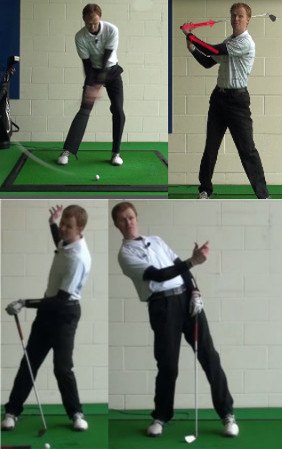
- Swinging all out. You very rarely – if ever – want to hit a golf shot while swinging at 100% effort. Sure, you can swing hard if you want to, but going at it with absolutely everything you have is a recipe for trouble. Swinging this hard makes it difficult to maintain an even tempo, and you will probably struggle to make good contact. Anything you gain in swing speed will likely be lost by striking the ball somewhere other than the sweet spot. By swinging with a little less than your maximum effort, you should stay in control and have a much easier time creating a clean strike.
- Getting disconnected. One of the key fundamentals in the golf swing is the connection between the club and your upper body. Ideally, you’ll keep the club in front of your chest throughout the swing, as this will help you find a good plane and it should promote a relatively square club face position. If you try to swing too hard, it’s likely that the club will get ‘stuck’ behind you during the transition from backswing to downswing. When this happens, the club trails too far behind and it’s nearly impossible to catch up in time to save the shot. In the end, you’ll probably hit one of two types of shots – a block out to the right, or a quick hook to the left. As you work on your swing, pay attention to the connection between your upper body and the club, and don’t too much separation develop. You might feel like you can generate more speed when you separate your upper body from the club as it trails behind on the way down, but you’ll only be creating trouble for yourself in the end.
- Losing balance. Keeping your balance should be a top priority in your golf swing. It’s more important to stay balanced than it is to swing hard, as an aggressive swing without balance is unlikely to be successful. So, as you practice, pay close attention to how well you are staying balanced, and stop yourself from taking your swing so far that your balance is negatively affected.
It’s great to add power to your swing, but it isn’t worth running into the problems above. Do your best to walk the line between swinging hard and going so far that some of these issues present themselves in your game.
— Turn Your Power into Lower Scores
Hitting the ball far is fun – but that fun will only last so long if you aren’t effectively turning those long shots into lower scores. With that in mind, we are going to wrap up this article with a section on how to use your new found power to achieve lower scores on the course. That’s what the game is all about, after all, so your ultimate goal should always be to use whatever skills you have in this game to write down the lowest possible number on the card.
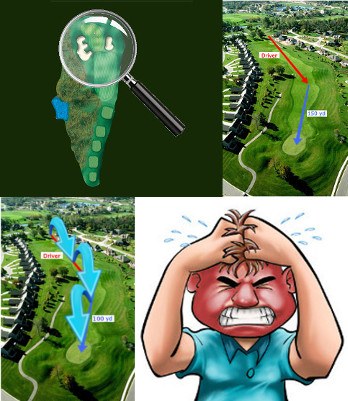
- Look for the right opportunities. On almost every golf course, there are opportunities where it will pay off to be aggressive with your power – and there are times when the best move is to stay back and play it safer. Your job as the golfer is to recognize when the golf course is giving you a chance to be aggressive, and when it’s best to simply stay out of trouble. Think of the design of the golf course as the defense that it is playing against you, in the same way that a basketball or football team would play defense against the opposition. The penalty areas, bunkers, rough, slopes, and more all come together to form a defense that is trying to stop you from shooting low scores. The idea is to adapt your game plan to best attack that defense. Using your power aggressively will be the right method in some situations, while other circumstances will call for a cautious, strategic approach.
- Attack the par fives. If you are able to develop your power to the point where you are hitting strong drives and fairway woods, use that power to go after the par fives aggressively in most cases. These are holes that are meant for scoring, and you don’t want to let them go by. Most courses have no more than four par five holes included in the design, so you only get so many chances to capitalize on. Unless you are playing a par five which is particularly well defended by a variety of obstacles, you should see these holes as opportunities to move your score in the right direction. With the right strategy, you may be able to record quite a few par five birdies – and maybe even an eagle!
- Reach the low spots. In golf, you want to be playing up the slopes whenever possible. It’s easier to control the distance of your shots when you are playing the ball uphill, so looking for low spots to position yourself is a standard part of golf strategy. Now that you have plenty of power on your side, you might be able to reach some of these low spots that would have been hard to get to otherwise. For instance, if you are playing a short par four that has a small dip in the fairway before running up to the green, you might be able to drive the ball into the low spot for an uphill pitch approach. As you make your way around a course, always be looking for the places you can leave your ball to have uphill chips, pitches, and putts.
- Keep your temper in check. This last point is about using your power responsibly when you get a little frustrated with your play. If you have had a few bad holes in a row, you might be tempted to get up onto the next tee and rip a driver as hard and far as you can. It may feel good to let off some steam that way but doing so could lead to another poor shot and more wasted strokes. Do your best to keep your temper out of the decision-making process and just focus on playing your best golf shot after shot. In the end, you’ll be glad you didn’t succumb to your temper and make the kinds of wild swings that almost always lead to bad results.
We hope you have enjoyed this discussion on the topic of power in the game of golf. There’s no doubt that power can help you shoot lower scores, but that will only be the case when you apply it in the right way. As long as you can improve your power without sacrificing anything else such as control or consistency, you’ll be well on your way to a better overall game. Good luck and have fun out there!






